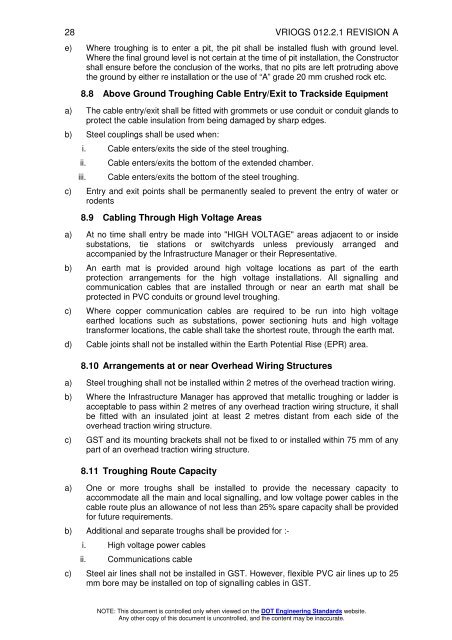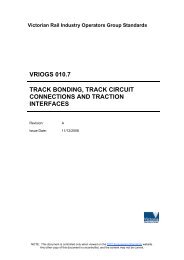VRIOGS 012.2.1 - Public Transport Victoria
VRIOGS 012.2.1 - Public Transport Victoria
VRIOGS 012.2.1 - Public Transport Victoria
Create successful ePaper yourself
Turn your PDF publications into a flip-book with our unique Google optimized e-Paper software.
28 <strong>VRIOGS</strong> <strong>012.2.1</strong> REVISION A<br />
e) Where troughing is to enter a pit, the pit shall be installed flush with ground level.<br />
Where the final ground level is not certain at the time of pit installation, the Constructor<br />
shall ensure before the conclusion of the works, that no pits are left protruding above<br />
the ground by either re installation or the use of “A” grade 20 mm crushed rock etc.<br />
8.8 Above Ground Troughing Cable Entry/Exit to Trackside Equipment<br />
a) The cable entry/exit shall be fitted with grommets or use conduit or conduit glands to<br />
protect the cable insulation from being damaged by sharp edges.<br />
b) Steel couplings shall be used when:<br />
i. Cable enters/exits the side of the steel troughing.<br />
ii.<br />
iii.<br />
Cable enters/exits the bottom of the extended chamber.<br />
Cable enters/exits the bottom of the steel troughing.<br />
c) Entry and exit points shall be permanently sealed to prevent the entry of water or<br />
rodents<br />
8.9 Cabling Through High Voltage Areas<br />
a) At no time shall entry be made into "HIGH VOLTAGE" areas adjacent to or inside<br />
substations, tie stations or switchyards unless previously arranged and<br />
accompanied by the Infrastructure Manager or their Representative.<br />
b) An earth mat is provided around high voltage locations as part of the earth<br />
protection arrangements for the high voltage installations. All signalling and<br />
communication cables that are installed through or near an earth mat shall be<br />
protected in PVC conduits or ground level troughing.<br />
c) Where copper communication cables are required to be run into high voltage<br />
earthed locations such as substations, power sectioning huts and high voltage<br />
transformer locations, the cable shall take the shortest route, through the earth mat.<br />
d) Cable joints shall not be installed within the Earth Potential Rise (EPR) area.<br />
8.10 Arrangements at or near Overhead Wiring Structures<br />
a) Steel troughing shall not be installed within 2 metres of the overhead traction wiring.<br />
b) Where the Infrastructure Manager has approved that metallic troughing or ladder is<br />
acceptable to pass within 2 metres of any overhead traction wiring structure, it shall<br />
be fitted with an insulated joint at least 2 metres distant from each side of the<br />
overhead traction wiring structure.<br />
c) GST and its mounting brackets shall not be fixed to or installed within 75 mm of any<br />
part of an overhead traction wiring structure.<br />
8.11 Troughing Route Capacity<br />
a) One or more troughs shall be installed to provide the necessary capacity to<br />
accommodate all the main and local signalling, and low voltage power cables in the<br />
cable route plus an allowance of not less than 25% spare capacity shall be provided<br />
for future requirements.<br />
b) Additional and separate troughs shall be provided for :-<br />
i. High voltage power cables<br />
ii.<br />
Communications cable<br />
c) Steel air lines shall not be installed in GST. However, flexible PVC air lines up to 25<br />
mm bore may be installed on top of signalling cables in GST.<br />
NOTE: This document is controlled only when viewed on the DOT Engineering Standards website.<br />
Any other copy of this document is uncontrolled, and the content may be inaccurate.

















